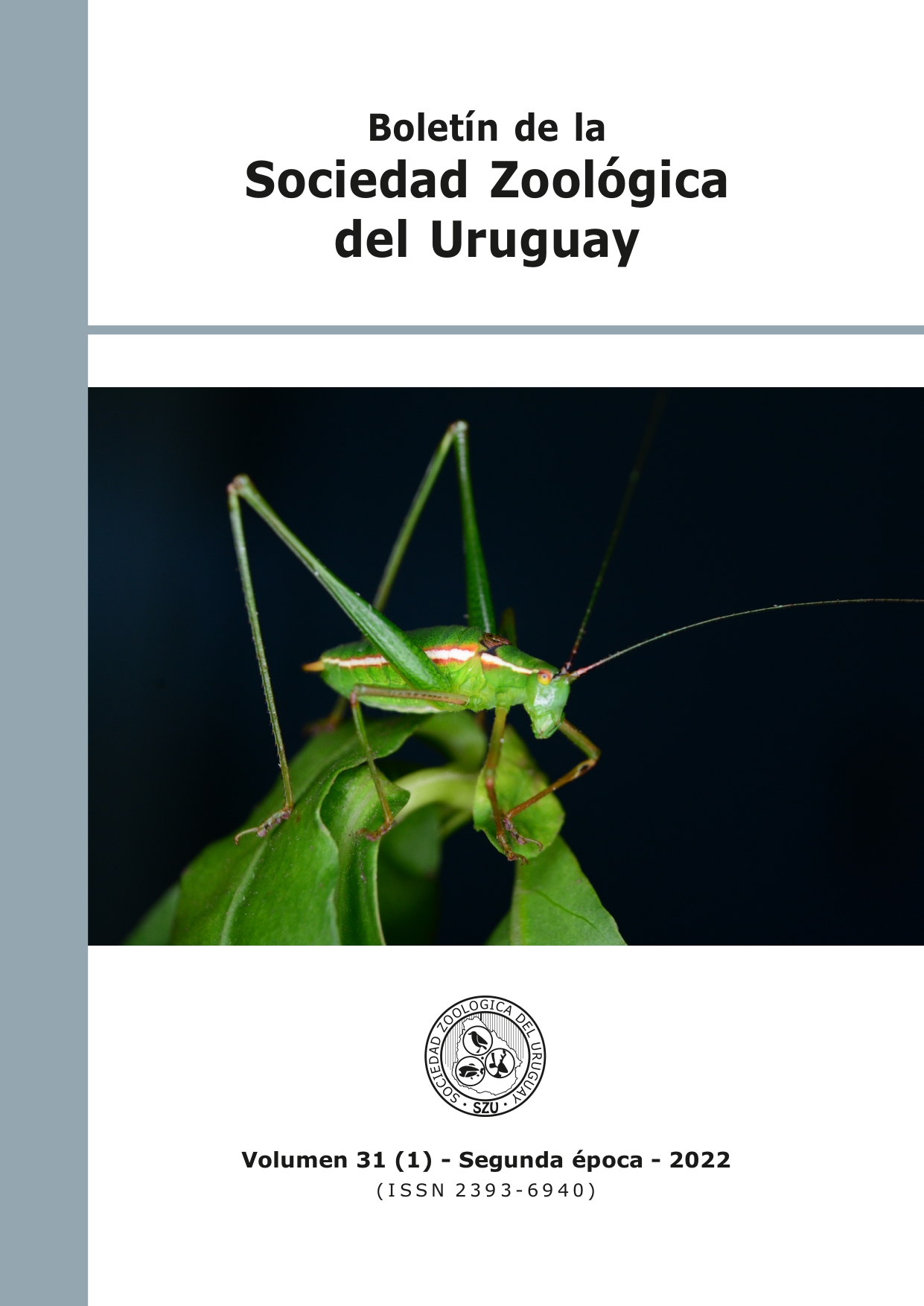¿ESTÁ BUENO CAMBIAR?: CAPTURA DE PRESAS DE DOS ARAÑAS LOBO CON DIFERENTES HÁBITOS DE VIDA
DOI:
https://doi.org/10.26462/31.1.3Palabras clave:
Lycosidae, errante, sustrato, tela en embudoResumen
Schizocosa malitiosa y Aglaoctenus lagotis son dos arañas lobo (Lycosidae) que habitan praderas y montes de Uruguay. Mientras S. malitiosa tiene hábito de vida errante, A. lagotis es sedentaria, y vive en tela. En este estudio, nos propusimos evaluar experimentalmente el comportamiento de captura de ambas especies en un sustrato “conocido” y en otro “ajeno”. Para ello colocamos a S. malitiosa (errante) en un sustrato de arena y posteriormente sobre la tela de A. lagotis. A la vez expusimos a A. lagotis (sedentaria) al sustrato tela y posteriormente sobre arena. Ambas especies capturaron menos presas en el sustrato ajeno: A. lagotis: 71% en tela, 35% en arena; S. malitiosa: 94% en arena, 47% en tela. Asimismo, A. lagotis tardó más en capturar a la presa en arena que en tela, mientras S. malitiosa no difirió en el tiempo de captura entre sustratos. Los resultados sugieren que A. lagotis tiene menos posibilidad de adaptarse a un cambio de sustrato, mientras S. malitiosa parece adaptarse más fácilmente al cambio. Se discute la estrategia de captura utilizada por cada una de las especies en ambos sustratos, así como si nuestros resultados apoyan el carácter basal de la vida en tela en Lycosidae.
Descargas
Citas
Aisenberg, A., Toscano-Gadea, C.A., y Ghione, S. (2011). Guía de Arácnidos del Uruguay, Montevideo, Uruguay: Ediciones De la Fuga.
Barth, F. G. (2002). Spider senses - technical perfection and biology. Zoology, 105(4), 271–285.
Bennet, T. J. y Lewis, R.D. (1979). Visual orientation in the Salticidae (Araneae). New Zealand Entomologist, 7(1), 58-63.
Blumstein, D.T., Evans, C.S. y Daniel, J.C. (2000). JWatcher, versión 1.0. https://www.jwatcher.ucla.edu/.
Capocasale, R.M. y Costa, F.G. (1975). Descripción de los biotopos y caracterización de los habitats de Lycosa malitiosa Tullgren (Araneae: Lycosidae) en Uruguay. Vie et Milieu, 25(1), sér. C, 1-15.
Cardoso, P., Pekár, S., Jocqué, R. y Coddington, J.A. (2011). Global patterns of guild composition and functional diversity of spiders. PLoS ONE, 6(6), e21710. http://dx.doi.org/10.1371/journal.pone.0021710.
Coddington, J.A. y Levi, H.W. (1991). Systematics and evolution of Spiders (Araneae). Annual Review of Ecology and Systematics, 22, 565-592.
Elias, D.O. y Mason, A.C. (2011). Signaling in variable environments: Substrate-borne signaling mechanisms and communication behavior in spiders. En: C.E. O’Connell-Rodwell (Ed.) The use of vibrations in communication: properties, mechanisms and function across taxa (pp. 25-46). Transworld Research Network, Kerala, India.
Elias, D.O., Mason, A.C. y Hoy, R.R. (2004). The effect of substrate on the efficacy of seismic courtship signal transmission in the jumping spider Habronattus dossenus (Araneae: Salticidae). The Journal of Experimental Biology, 207, 4105-4110.
Elias, D.O., Sivalinghem, S., Mason, A.C., Andrade, M.C.B. y Kasumovic, M.M. (2010). Vibratory Communication in the Jumping Spider Phidippus clarus: Substrate-borne courtship signals are important for male mating success. Ethology, 116, 990-998.
Foelix, R. (2010). Biology of Spiders 3rd Edition. New York, USA: Oxford University Press.
Foelix, R.F. y Chu-Wang, I-Wu. (1973). The morphology of spider sensilla II. Chemoreceptors. Tissue and Cell, 5(3), 461-478.
Forster, L.M. (1979). Visual mechanisms of hunting behavior in Trite planiceps a jumping spider (Araneae: Salticidae). New Zealand Journal of Zoology, 6, 79-93.
González, M., Costa, F.G. y Peretti, A.V. (2015b). Funnel-web construction and estimated immune costs in Aglaoctenus lagotis (Araneae: Lycosidae). Journal of Arachnology, 43(2), 158-167.
González, M., Peretti, A.V. y Costa, F.G. (2015a). Efecto del sustrato sobre el cortejo de dos arañas lobo, una de tela y otra errante. Boletín de la Sociedad Zoológica del Uruguay (2ª época), 24(2), 57-72.
González, M., Peretti, A.V, Viera, C. y Costa, F.G. (2013). Differences in sexual behavior of two distant populations of the funnel-web wolf spider Aglaoctenus lagotis. Journal of Ethology, 31, 175-184.
González, M. y Toscano, C.A. (2021). Can’t even trust the family? The web of the unusual web-building wolf spider Aglaoctenus lagotis (Araneae: Lycosidae) invaded by typical wandering wolf spiders. Arachnology, 18(7), 710–714.
Gordon, S.D. y Uetz, G.W. (2011). Multimodal communication of wolf spiders on different substrates: evidence for behavioral plasticity. Animal Behaviour, 81, 367-375.
Hammer, O., Harper, D.A.T., y Ryan, P.D. (2003). Past Palaeontological Software, version 1.18 http://folk.uio.no/ohammer/past.
Hatley, C.L. y Macmahon, J.A. (1980). Spider community organization: seasonal variation and the role of vegetation architecture. Environmental Entomology, 9(5), 632-639.
Hebets, E. y Uetz, G.W. (1999). Female responses to isolated signals from multimodal male courtship displays in the wolf spider genus Schizocosa (Araneae: Lycosidae). Animal Behaviour, 57, 865-872.
Hebets, E.A., Elias, D.O., Masonz, A.C., Miller, G.L. y Stratton, G.E. (2008). Substrate-dependent signaling success in the wolf spider, Schizocosa retrorsa. Animal Behaviour, 75, 605-615.
Hostettler, S. y Nentwig, W. (2006). Olfactory information saves venom during prey-capture of the hunting spider Cupiennius salei (Araneae: Ctenidae). Functional Ecology, 20, 369-375.
Jackson, D.E. (2009). Nutritional ecology: a first vegetarian spider. Current Biology, 19, 894-895.
Jackson, R.R., Pollard, S.D., Nelson, X.J., Edwards, G.B. y Barrion, A.T. (2001). Jumping spiders (Araneae: Salticidae) that feed on nectar. Journal of Zoology, 255, 25–29.
Jocqué, R. (1995). Spider strategies: beyond the web. Nouvelles de la Science et des Technologies, 13, 289-298.
Jocqué, R. y Alderweireldt, M. (2005). Lycosidae: the grassland spiders. Acta zoologica bulgarica, 1, 125-130.
Kotiaho, J., Alatalo, R.V., Mappes, J. y Parri, S. (1996). Sexual selection in a wolf spider: male drumming activity, body size, and viability. Evolution, 50(5), 1977-1981.
Kronk, A. E. y Riechert, S. E. (1979). Parameters affecting the hábitat choice of desert Wolf spider, Lycosa santrita Chamberlin and Ivie. Journal of Arachnology, 7, 155-166.
Lopes Rodrigues, E.N. y Mendonça, Jr M.S. (2012). Spider guilds in the tree-shrub strata of riparian forests in southern Brazil. The Journal of Arachnology, 40, 39-47.
Marshall, S.D. (1995). Natural history, activity patterns, and relocation rates of a burrowing wolf spider: Geolycosa xera archiboldi (Araneae, Lycosidae). Journal of Arachnology, 23, 65-70.
Meza, P., Elias, D.O. y Rosenthal, M.F. (2021). The effect of substrate on prey capture does not match natural substrate use in a wolf spider. Animal Behaviour, 176, 17-21.
Murphy, N.P., Framenau, V.W., Donellan, S.C., Harvey, M. S., Park, Y.C. y Austin, A.D. (2006). Phylogenetic reconstruction of the wolf spiders (Araneae: Lycosidae) using sequences from the 12S rRNA, 28S rRNA, and NADH1 genes: implications for classification, biogeography, and the evolution of web building behavior. Molecular Phylogenetics and Evolution, 38, 583-602.
Nakamura, K. (1982). Prey capture tactics of spiders: An analysis based on a simulation model for spider's growth. Researches on Population Ecology, 24, 302-317.
Nyffeler, M. y Altig, R. (2020). Spiders as frog-eaters: a global perspective. Journal of Arachnology, 48, 26-42.
Nyffeler, M. y Sunderland, K.D. (2003). Composition, abundance and pest control potential of spider communities in agroecosystems: a comparison of European and US studies. Agriculture, Ecosystems and Environment, 95, 579-612.
Nyffeler, M. y Symondson, W.O.C. (2001). Spiders and harvestmen as gastropod predators. Ecological Entomology, 26, 617-628.
Nyffeler, M., Moor, H. y Foelix, R.F. (2001). Spiders feeding on earthworms. The Journal of Arachnology, 29(1), 119-124.
Nyffeler, M., Olson, E.J. y Symondson, W.O.C. (2016). Plant-eating by spiders. Journal of Arachnology, 44, 15-27.
Nyffeler, M. y Gibbons, J.W. (2021). Spiders (Arachnida: Araneae) feeding on snakes (Reptilia: Squamata). The Journal of Arachnology, 49(1), 1-27.
Persons, M.H. y Uetz, G.W. (1997). The effect of prey movement on attack behavior and patch residence decision rules of Wolf spiders (Araneae: Lycosidae). Journal of Insect Behavior, 10(5), 737-752.
Piacentini, L.N. y Ramírez, M.J. (2019). Hunting the wolf: A molecular phylogeny of the wolf spiders (Araneae, Lycosidae). Molecular Phylogenetics and Evolution, 136, 227-240.
Pintos, P., Toscano-Gadea, C.A., González, M., Postiglioni, R., Gonnet, V., Kacevas, N., Cavassa, D. y Aisenberg, A. (en prensa). De tal palo, tal astilla: progenie de arañas lobo del Uruguay (Araneae: Lycosidae). Boletín de la Sociedad Zoológica del Uruguay, 30(1), 28-35 ISSN 2393-6940.
RStudio Team (2020). RStudio: Integrated Development for R. RStudio, PBC, Boston, MA. http://www.rstudio.com/.
Richman, D.B. y Jackson, R.R. (1992). A review of the ethology of jumping spiders (Araneae, Salticidae). Bulletin of the British Arachnological Society, 9(2), 33-37.
Riechert, S. y Łuczak, J. (2014). Spider foraging: behavioral responses to prey. En: P.N Witt y J.S Rovner (Eds.) Spider communication: mechanisms and ecological significance (pp. 353-386). Princeton University Press, New Jersey, EEUU.
Rosenthal, M.F., Hebets, E.A., Kessler, B., McGinley, R., y Elias, D.O. (2019). The effects of microhabitat specialization on mating communication in a wolf spider. Behavioral Ecology, 30(5), 1398-1405.
Rypstra, A.L., Schmidt, J.M., Reif, B.D., DeVito, J., y Persons, M.H. (2007). Tradeoffs involved in site selection and foraging in a wolf spider: effects of substrate structure and predation risk. Oikos, 116(5), 853-863.
Sordi, S. (1996). Ecologia de populaçoes da aranha Porrimosa lagotis (Lycosidae) nas reservas Mata de Santa Genebra, Campinas (SP) e Serra do Japi, Jundai (SP). PhD Thesis, Universidade Estadual de Campinas, Sao Paulo, Brasil.
Stafstrom, J.A. y Hebets, E.A. (2016) Nocturnal foraging enhanced by enlarged secondary eyes in a net-casting spider. Biology Letters, 12, http://dx.doi.org/10.1098/rsbl.2016.0152.
Uetz, G.W. (1992). Foraging strategies of Spiders. Trends in Ecology and Evolution, 7(5), 155-159.
Uetz, G.W., Halaj, J. y Cady, A.B. (1999). Guild structure of spiders in major crops. The Journal of Arachnology, 27, 270-280.
Uetz, G.W., Clark, D.L. y Roberts, J.A. (2016). Multimodal communication in wolf spiders (Lycosidae) - An emerging model for study. Advances in the Study of Behavior, 48, http://dx.doi.org/10.1016/bs.asb.2016.03.003.
Uhl, G. (2013). Spider Olfaction: Attracting, detecting, luring and avoiding. En: W. Nentwig (Ed.), Ecophysiology Spider (pp. 141-157). Springer-Verlag, Berlin, Heidelberg.
Vasconcellos-Neto, J., Romero, G.Q., Santos, A.J. y Dippenaar-Schoeman, A.S. (2007). Associations of spiders of the genus Peucetia (Oxyopidae) with plants bearing glandular hairs. Biotropica, 39, 221–226.
Walker, S.E., y Rypstra, A.L. (2002). Sexual dimorphism in trophic morphology and feeding behavior of wolf spiders (Araneae: Lycosidae) as a result of differences in reproductive roles. Canadian Journal of Zoology, 80(4), 679-688.
Willemart, R.H y Lacava, M. (2017). Foraging strategies of cursorial and ambush spiders. En: (C. Viera y M.O Gonzaga Eds.) Behaviour and ecology of spiders (pp. 227-245). Springer, Cham, Switzerland.
Wilgers, D.J. y Hebets, E.A. (2011). Complex courtship displays facilitate male reproductive success and plasticity in signaling across variable environments. Current Zoology, 57(2), 175-186.
World Spider Catalog. (2021). World Spider Catalog, Version 22.0. Natural History Museum Bern, online at http://wsc.nmbe.ch, accessed in March 2021. doi: 10.24436/2
Zehethofer, K. y Sturmbauer, C. (1998). Phylogenetic relationships of central European wolf spiders (Araneae: Lycosidae) inferred from 12S ribosomal DNA sequences. Molecular phylogenetics and evolution, 10(3), 391-398.











